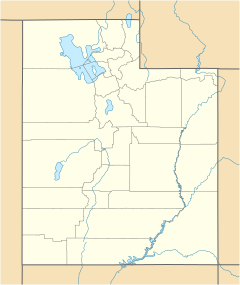Corn Creek (Millard County, Utah) facts for kids
Quick facts for kids Corn Creek |
|
|---|---|
| Physical characteristics | |
| Main source | Confluence of East Fork Corn Creek and West Fork Corn Creek 7,313 ft (2,229 m) 38°45′40″N 112°15′05″W / 38.76111°N 112.25139°W |
| River mouth | Kanosh 4,918 ft (1,499 m) 38°49′13.88″N 112°26′22.78″W / 38.8205222°N 112.4396611°W |
Corn Creek, also known as Kanosh Creek, is a small stream in Millard County, Utah. It flows into the Pahvant Valley. The creek starts where two smaller streams, East Fork Corn Creek and West Fork Corn Creek, meet in the Pahvant Range.
History of Corn Creek
The area near the end of Corn Creek was once a popular stopping place. Early travelers on the Mormon Road called it Willow Flats. On January 17, 1851, a leader named George A. Smith wrote about this spot. He told Brigham Young that it was a great place for a new settlement.
Smith noted that Corn Creek created a large meadow. He said the area had excellent grazing land and good soil. Many farmers in his group would have been happy to stay there.
Indian Farm and Settlement
Starting in 1851, Brigham Young helped set up an Indian farm at Corn Creek. This farm was for the Pahvant Indians. It was one of three such farms in Utah Territory. Settlers from Fillmore grew crops like potatoes, wheat, and corn. These crops added to what the Pahvants already grew.
The Pahvants, led by Chief Kanosh, had grown beans, corn, and squash for years. At Kanosh's request, they learned new farming methods from Mormon settlers. The Corn Creek Indian Farm operated from 1855 to 1867. After that, most native residents moved to a new reservation. This left the land open for the new settlement of Kanosh.
Petersburg and Hatton
In 1859, more settlers from Fillmore created a new community. It was located where the Mormon Road crossed the creek. This spot was northwest of the Corn Creek village and farm. The new settlement was named Petersburg after Peter Robison, its first postmaster.
Petersburg was an important rest stop from 1864 to 1871. It was on the stagecoach line that connected the Utah Central Railroad to the mining town of Pioche, Nevada. From 1877 to 1940, the farming community had a post office called Hatton. Today, this settlement is a ghost town. There is little left to see of its past among the irrigated fields.


